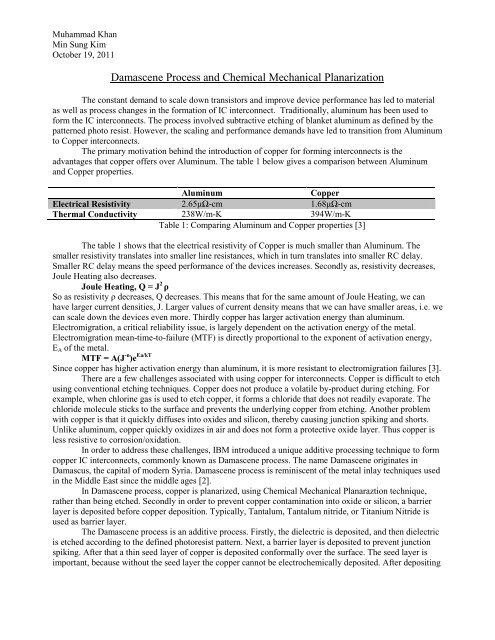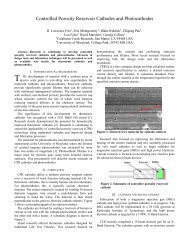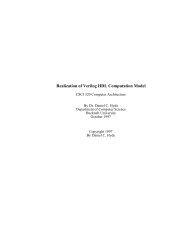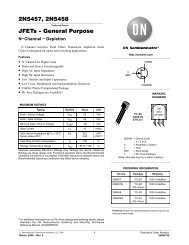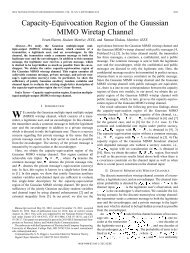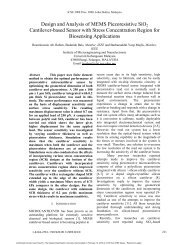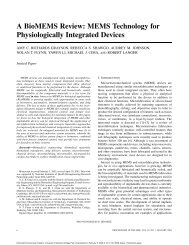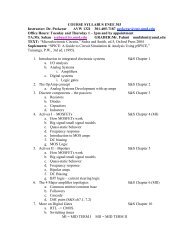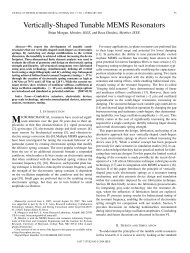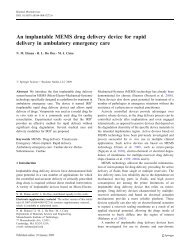Damascene Process Report - ECE
Damascene Process Report - ECE
Damascene Process Report - ECE
Create successful ePaper yourself
Turn your PDF publications into a flip-book with our unique Google optimized e-Paper software.
Muhammad Khan<br />
Min Sung Kim<br />
October 19, 2011<br />
<strong>Damascene</strong> <strong>Process</strong> and Chemical Mechanical Planarization<br />
The constant demand to scale down transistors and improve device performance has led to material<br />
as well as process changes in the formation of IC interconnect. Traditionally, aluminum has been used to<br />
form the IC interconnects. The process involved subtractive etching of blanket aluminum as defined by the<br />
patterned photo resist. However, the scaling and performance demands have led to transition from Aluminum<br />
to Copper interconnects.<br />
The primary motivation behind the introduction of copper for forming interconnects is the<br />
advantages that copper offers over Aluminum. The table 1 below gives a comparison between Aluminum<br />
and Copper properties.<br />
Aluminum Copper<br />
Electrical Resistivity 2.65μΩ-cm 1.68μΩ-cm<br />
Thermal Conductivity 238W/m-K 394W/m-K<br />
Table 1: Comparing Aluminum and Copper properties [3]<br />
The table 1 shows that the electrical resistivity of Copper is much smaller than Aluminum. The<br />
smaller resistivity translates into smaller line resistances, which in turn translates into smaller RC delay.<br />
Smaller RC delay means the speed performance of the devices increases. Secondly as, resistivity decreases,<br />
Joule Heating also decreases.<br />
Joule Heating, Q = J 2 ρ<br />
So as resistivity ρ decreases, Q decreases. This means that for the same amount of Joule Heating, we can<br />
have larger current densities, J. Larger values of current density means that we can have smaller areas, i.e. we<br />
can scale down the devices even more. Thirdly copper has larger activation energy than aluminum.<br />
Electromigration, a critical reliability issue, is largely dependent on the activation energy of the metal.<br />
Electromigration mean-time-to-failure (MTF) is directly proportional to the exponent of activation energy,<br />
EA of the metal.<br />
MTF = A(J -n )e Ea/kT<br />
Since copper has higher activation energy than aluminum, it is more resistant to electromigration failures [3].<br />
There are a few challenges associated with using copper for interconnects. Copper is difficult to etch<br />
using conventional etching techniques. Copper does not produce a volatile by-product during etching. For<br />
example, when chlorine gas is used to etch copper, it forms a chloride that does not readily evaporate. The<br />
chloride molecule sticks to the surface and prevents the underlying copper from etching. Another problem<br />
with copper is that it quickly diffuses into oxides and silicon, thereby causing junction spiking and shorts.<br />
Unlike aluminum, copper quickly oxidizes in air and does not form a protective oxide layer. Thus copper is<br />
less resistive to corrosion/oxidation.<br />
In order to address these challenges, IBM introduced a unique additive processing technique to form<br />
copper IC interconnects, commonly known as <strong>Damascene</strong> process. The name <strong>Damascene</strong> originates in<br />
Damascus, the capital of modern Syria. <strong>Damascene</strong> process is reminiscent of the metal inlay techniques used<br />
in the Middle East since the middle ages [2].<br />
In <strong>Damascene</strong> process, copper is planarized, using Chemical Mechanical Planaraztion technique,<br />
rather than being etched. Secondly in order to prevent copper contamination into oxide or silicon, a barrier<br />
layer is deposited before copper deposition. Typically, Tantalum, Tantalum nitride, or Titanium Nitride is<br />
used as barrier layer.<br />
The <strong>Damascene</strong> process is an additive process. Firstly, the dielectric is deposited, and then dielectric<br />
is etched according to the defined photoresist pattern. Next, a barrier layer is deposited to prevent junction<br />
spiking. After that a thin seed layer of copper is deposited conformally over the surface. The seed layer is<br />
important, because without the seed layer the copper cannot be electrochemically deposited. After depositing
the seed layer, the structure is electroplated with copper. Final step is to planarize the excess copper. The<br />
process steps are shown in figure 1 below:<br />
A variation of <strong>Damascene</strong> process is Dual <strong>Damascene</strong> process. In this process, the vias and the metal<br />
lines are created by etching holes and trenches in the dielectric, after which copper is deposited in a single<br />
step. In Dual <strong>Damascene</strong> process, one photo/etch step is needed for making holes for vias in the dielectric<br />
and another photo/etch step is needed for making trenches for metal lines. These two photo/etch steps can be<br />
performed in any order, i.e. via first then trench or trench first then via. The process steps are shown in figure<br />
2 below:<br />
Fig. 2 : Dual <strong>Damascene</strong> <strong>Process</strong> [2]<br />
Chemical Mechanical Planarization (CMP) is “a process of smoothing wafer surfaces with the<br />
combination of chemical and mechanical forces” [8]. The main reason for using a hybrid of chemical etching<br />
and free abrasive polishing is because mechanical grinding alone causes too much damage to the wafer<br />
surface, while chemical etching alone does not promote good planarization of surface. This process is<br />
generally used to remove silicon oxide, poly silicon, and metal surfaces and to provide plane surfaces.<br />
There are several components involved in CMP. First, there is platen, which is a rotating base that<br />
holds all the components on top. Abrasive sponge-like pad covers platen and rotates with the platen to
mechanically polish the surface of wafer. Wafer carrier is composed of retaining ring, backing film, carrier<br />
housing, and back press vacuum. A wafer is held upside down by retaining ring on a backing film. The<br />
retaining ring keeps the wafer in correct horizontal position for even polishing. Both the pad and wafer<br />
carrier are then counter rotated while slurry containing both abrasives and reactive chemicals is passed<br />
underneath. The following figure illustrates the design of CMP.<br />
Figure 3 Illustration of Chemical Mechanical Planarization Machine [5].<br />
CMP is achieved through applying load force provided by back press vacuum on the back of the<br />
wafer. When the pressure is applied on the wafer, the higher surfaces are polished away to level the surface<br />
layer. Also, most chemical reactions are isotropic and etch different crystal planes with different speed. CMP<br />
involves both chemical and mechanical effects at the same time. Some variables, such as temperature of the<br />
system, back pressure, velocity of the rotation, and slurry flow rate, play important roles in the quality of<br />
planarization. Typical process conditions are temperature from 10 °C to 70 °C, back pressure from 2 psi to 7<br />
psi, velocity from 20 rpm to 80 rpm, and slurry flow rate from 100 mL/min to 200 mL/min. Typical removal<br />
rate for silicon oxide layer is approximately 2800Å/min and for metal is approximately 3500 Å/min.<br />
The advantages of CMP are good selectivity, reduction of resist thickness variation,<br />
increased resolution of photolithographic process, improved step coverage of subsequent layer<br />
deposition, and multi-level interconnection. CMP encourages no lapping, which means that it will<br />
only polish the selected material and stop polishing at non-selective layer, whereas different<br />
planarization techniques may remove different materials at the same rate. Also, because CMP<br />
smoothes the surface layer, this accounts for reduction of resist thickness variation. Any higher<br />
surfaces are polished away to level the surface layer. CMP is essential for multi-layer chips. Neat<br />
planarization will improve step coverage of subsequent layer deposition, such as metal copper or<br />
aluminum, thus it maximizes the interconnection between the surface layers. This will promote<br />
multi-layer chips to be faster and more reliable because any bad connection between layers will be<br />
minimized. CMP also increases the resolution of photolithographic process by reducing the depth of<br />
focus. In order to project a photolithographic beam onto the surface of a wafer, the roughness of the<br />
surface of the wafer must be less than half of the depth of focus of the wafer. Smoothing the surface<br />
layer will reduce the depth of focus, therefore, improving the resolution of photolithography.<br />
Nevertheless, there are some limitations seen by CMP. Dishing and erosion occurs due to<br />
local planarization in which some areas of the wafer polish faster than the others. Dishing results in<br />
a well-like shape. CMP is also subjected to stress cracking, scratching, and corrosive attacking from<br />
slurry chemicals. The wafer is very weak and thin; as a result, over pressuring the wafer will lead to<br />
stress cracking or scratching the surface of the wafer. CMP process is also time-consuming and<br />
expensive.
Works Cited<br />
[1] Richard et al., “Demystifying Chipmaking”, Elsevier, 2005.<br />
[2] San Jose University Engineering Department, “Copper Deposition”, [Online], Available:<br />
http://www.engr.sjsu.edu/ sgleixner/mate166/LectureNotes/Copper%20and%20<strong>Damascene</strong>_S.pdf<br />
[Accessed: 17 Oct. 2011]<br />
[3] Michael Quirk and Julian Serda, “Semiconductor Manufacturing Technology”, 1 st ed., Prentice<br />
Hall, 2000.<br />
[4] Robert Doering and Yoshio Nishi, Eds., “Handbook of Semiconductor Manufacturing<br />
Technology”, 2 nd ed., CRC Press, 2007.<br />
[5] Alpsitec SARL. “Alpsitec is represented by Crystec Technology Trading GmbH,”<br />
http://www.crystec.com/alpovere.htm.<br />
[6] Joshua Chien, University of California Berkeley, CA, Chemical Mechanical Planarization.<br />
[Microsoft PowerPoint]. Berkeley, CA: Rohm & Haas.<br />
[7] Jeffrey Rockwell and Yuzhuo Li, “Chemical Mechanical Polishing,” 2000,<br />
http://www.files.chem.vt.edu/confchem/2000/a/rockwell/rockwell.htm.<br />
[8] Wikipedia, “Chemical-mechanical planarization,” 30 June 2011,<br />
http://en.wikipedia.org/wiki/Chemical-mechanical_planarization.


